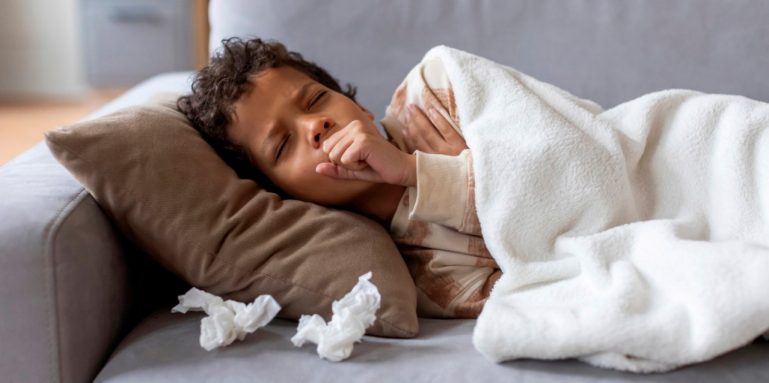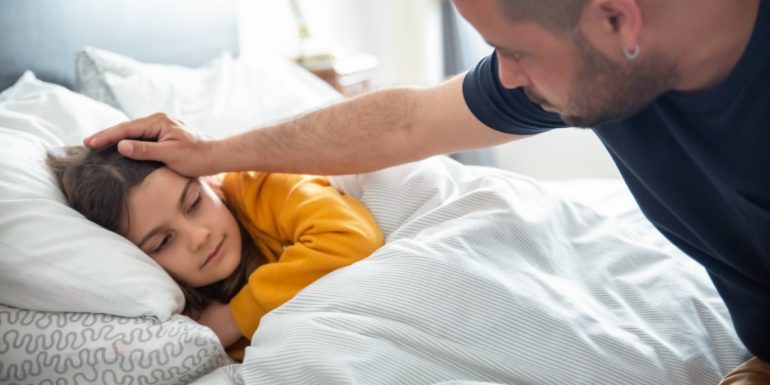
Rubella: symptoms, progression and dangers
How can you recognise rubella and is rubella dangerous? How long is rubella contagious for? When and how often should you have the rubella vaccine? The childhood illness rubella explained.
Was sind Röteln?
Rubella – also known as German measles – is a contagious disease mainly characterised by a rash on the body. Although rubella is a childhood illness, adults can get it too. If pregnant women get rubella, it can have serious consequences for the child, especially in the first 16 weeks of pregnancy.
Rubella is caused by the rubella virus. It is an airborne infection spread by coughing or sneezing.
In Switzerland, the number of rubella cases has decreased significantly thanks to the vaccine, and today no more than around two cases are reported per year. Cases of rubella must be reported. This means that laboratories pass on results to the Swiss Federal Office of Public Health (FOPH).
The rubella vaccine protects children, adults and, above all, pregnant women against rubella and its long-term effects. There is no single vaccine against rubella in Switzerland; there is a combined MMR vaccine against measles, mumps and rubella. There is also an MMRV vaccine, which additionally protects against chickenpox. The first vaccination is recommended at the age of 9 months, with the second dose at 12 months. Thanks to the vaccine, there are hardly any cases in Switzerland these days. The likelihood of your child getting rubella despite being vaccinated is very low. In these instances, there is insufficient or no immunisation because only the first dose of the vaccine has been administered.
How can you recognise rubella?
You may have rubella without any symptoms at all, or with unspecific symptoms similar to a normal cold. Typical rubella symptoms include:
- Swollen lymph nodes: rubella in children can make the lymph nodes in the neck and throat area swell up. This is often painful.
- Cold symptoms: coughing, a runny nose and mild headaches, sometimes accompanied by conjunctivitis. This causes red, itchy eyes.
- Rash: the rubella rash (exanthem) first appears behind the ears and then spreads across the face and body. The rash appears everywhere, not only on the stomach. The exanthem manifests itself as small, light red, slightly raised spots. Rubella rarely causes itching. The rash disappears after two to three days.
- Fever: a rubella infection can cause a slight fever of up to 38 degrees.
Do you think you or your child might have rubella? To protect unvaccinated people – especially pregnant women – it’s a good idea to seek medical advice.
Can rubella lead to complications?
Most children do not suffer any complications from rubella. Only around 50% of infected children show any visible symptoms. If they occur, they generally disappear again after a week.
Rubella in adults causes similar symptoms to rubella in children. Most adult men or women who have rubella are unvaccinated. Special caution is necessary during pregnancy. But why is rubella during pregnancy so dangerous? If the rubella virus is transferred to an unborn child, it can cause serious harm to their heart, brain, eyes and inner ear, which is known as “rubella embryopathy”. The likelihood of this is highest in the first 12 weeks of pregnancy.
Important: if you’re planning to conceive, it is very important that you check your vaccination status and, if necessary, get the rubella vaccine before you get pregnant. This way you can protect your baby from rubella and serious long-term harm.
Incubation period: how long is rubella contagious for?
The incubation period – the time from infection to the first symptoms – for rubella is generally between 14 and 21 days. Rubella is already contagious one week before the rash appears. There is still a risk of infection for about a week after the appearance of the skin changes.
Rubella: what can you do?
There is no cure for rubella. This is why treatment for rubella focuses on alleviating the symptoms. Potential measures include:
- Fever-reducing medication: ibuprofen and paracetamol alleviate fever and pain. Consult your paediatrician beforehand to make sure you choose the right dosage for your child.
- Calf compress: cool, damp cloths around your child’s calves can reduce their fever. Apply the cloth for about 10 minutes and, if necessary, slowly increase the length of application to 20 to 30 minutes.
- Bed rest: sleep promotes recovery, so your child should get plenty of rest.
- Staying hydrated: it’s important to make sure your child drinks enough fluids when they have a fever.
- Itching: rubella can sometimes cause slight itching. Use mild replenishing creams to alleviate itching caused by rubella.
Consult your child’s paediatrician if their rubella symptoms worsen. Rubella is, however, generally harmless for young children.
Rubella – or maybe a different childhood illness?
In newborn babies and young children, rubella can easily be mistaken for other childhood illnesses. This is because many childhood illnesses – whether it’s measles, rubella, fifth disease or other illnesses – cause a rash. Even experts sometimes have difficulty telling these illnesses apart:
- Measles: the rash consists of flat red spots. The difference between rubella and measles is that measles causes white spots to appear on the mucous membrane of the mouth.
- Scarlet fever: with scarlet fever, the rash mainly appears in the armpits and inner thighs. If you’re not sure whether your child has rubella or scarlet fever, look at their tongue. If they have rubella, their tongue will not be affected, unlike with scarlet fever.
- Fifth disease: fifth disease causes a pronounced butterfly-shaped rash on the cheeks and spreads as a flat red rash on the arms, legs and other parts of the body.
- Chickenpox: rubella and chickenpox first start with red spots. In the case of chickenpox, these spots itch and become blisters.
If your child has a rash, consult your paediatrician. They will determine whether your child has rubella and will initiate the appropriate treatment.

The expert provided the editorial team with expert advice and input for this article. Simeon Zürcher (PhD in Epidemiology and Biostatistics) works as a researcher in the Public Health Sciences team at Helsana.


Newsletter
Find out more about current health issues every month and get all the information you need about our attractive offers from all Helsana Group companies * delivered by e-mail to read whenever it suits you. Our newsletter is free of charge and you can sign up here:
We did not receive your information. Please try again later.
* The Helsana Group comprises Helsana Insurance Company Ltd, Helsana Supplementary Insurances Ltd and Helsana Accidents Ltd.